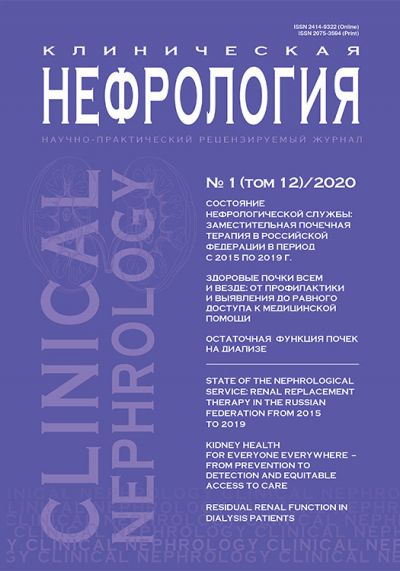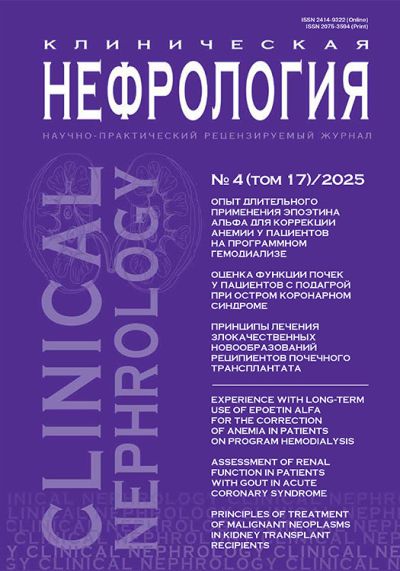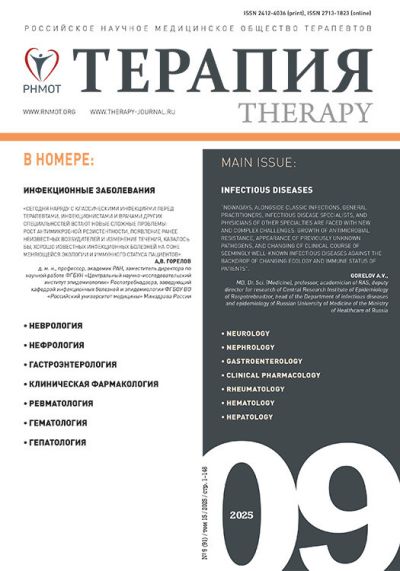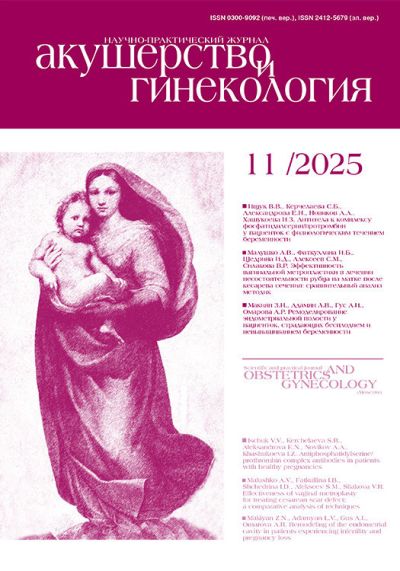Клиническая Нефрология №1 / 2020
Здоровые почки всем и везде: от профилактики и выявления до равного доступа к медицинской помощи
1) Department of Medicine and Therapeutics, Carol & Richard Yu PD Research Centre, Prince of Wales Hospital, Chinese University of Hong Kong, Hong Kong;
2) Nephrology Service, Hospital Civil de Guadalajara Fray Antonio Alcalde, University of Guadalajara Health Sciences Center, Guadalajara, Jal., Mexico;
3) Division of Health System, Policy and Management, Jockey Club School of Public Health and Primary Care, The Chinese University of Hong Kong, Hong Kong;
4) James Whitcomb Riley Hospital for Children, Indiana University School Of Medicine, Indianapolis, USA;
5) World Kidney Day Office, Avenue des Arts, Brussels, Belgium;
6) Tanker Foundation, Chennai, India;
7) Division of Nephrology and Hypertension, 1st Department of Internal Medicine, AHEPA Hospital, Aristotle University of Thessaloniki, Thessaloniki, Greece;
8) Nephrology Unit, Department of Internal Medicine, Faculty of Medicine, Cairo University, Giza, Egypt;
9) Renal Unit, Department of Medicine, College of Medicine, University of Nigeria, Ituku-Ozalla, Enugu, Nigeria;
10) Division of Nephrology and Hypertension and Kidney Transplantation, University of California Irvine School of Medicine, Orange, CA, USA
The global burden of chronic kidney disease (CKD) is rapidly increasing with a projection of becoming the 5th most common cause of years of life lost globally by 2040. Aggravatingly, CKD is a major cause of catastrophic health expenditure. The costs of dialysis and transplantation consume up to 3% of the annual healthcare budget in high-income countries. Crucially, however, the onset and progression of CKD is often preventable. In 2020, the World Kidney Day campaign highlights the importance of preventive interventions – be it primary, secondary or tertiary. This complementing article focuses on outlining and analyzing measures that can be implemented in every country to promote and advance CKD prevention. Primary prevention of kidney disease should focus on the modification of risk factors and addressing structural abnormalities of the kidney and urinary tracts, as well as exposure to environmental risk factors and nephrotoxins. In persons with pre-existing kidney disease, secondary prevention, including blood pressure optimization and glycemic control, should be the main goal of education and clinical interventions. In patients with advanced CKD, management of co-morbidities such as uremia and cardiovascular disease is a highly recommended preventative intervention to avoid or delay dialysis or kidney transplantation. Political efforts are needed to proliferate the preventive approach. While national policies and strategies for non-communicable diseases might be present in a country, specific policies directed toward education and awareness about CKD screening, management and treatment are often lacking. Hence, there is an urgent need to increase the awareness of the importance of preventive measures throughout populations, professionals and policy makers.
ABBREVIATION LIST
- ACEI Angiotensin converting enzyme inhibitor
- ADPKD Autosomal Dominant Polycystic Kidney Disease
- AIN Acute interstitial nephritis
- AKI Acute kidney injury
- APOL1 Apolipoprotein 1
- ATN Acute tubular necrosis
- BPH Benign prostate hypertrophy
- CKD Chronic kidney disease
- CKDu Chronic kidney disease of unknown cause
- CNI Calcineurin inhibitor
- CVD Cardiovascular disease
- ESRD End-stage renal disease
- GFR Glomerular filtration rate
- GN Glomerulonephritis
- ISN International Society of Nephrology
- KDIGO Kidney Disease Improving Global Outcomes
- LMIC Low middle income countries
- MDC Multidisciplinary Clinic
- NASH Non-alcoholic steatohepatitis
- NCD Non-communicable disease
- NHSP National Health Screening Program
- NICE National Institute of Clinical Excellence
- NSAID Non-steroidal anti-inflammatory drugs
- PEW Protein energy wasting
- PPI Proton pump inhibitor
- RAASi Renin-angiotensin-aldosterone system inhibitors
- SDG Sustainable Development Goal
- SDPI Special Diabetes Program for Indians
- SGLT2i Sodium-glucose cotransporter-2 Inhibitors
- UHC Universal Health Coverage
- UN United Nation
- WHO World Health Organization
Introduction
Around 850 million people currently are affected by different types of kidney disorders [1]. Up to one in ten adults worldwide has chronic kidney disease (CKD), which is invariably irreversible and mostly progressive. The global burden of CKD is increasing, and CKD is projected to become the 5th most common cause of years of life lost globally by 2040 [2]. If CKD remains uncontrolled and if the affected person survives the ravages of cardiovascular and other complications of the disease, CKD progresses to end-stage renal disease (ESRD), where life cannot be sustained without dialysis therapy or kidney transplantation. Hence, CKD is a major cause of catastrophic health expenditure [3]. The costs of dialysis and transplantation consume 2–3% of the annual health-care budget in high-income countries; spent on less than 0,03% of the total population of these countries [4].
Importantly, however, kidney disease can be prevented and progression to ESRD can be delayed with appropriate access to basic diagnostics and early treatment including life style modifications and nutritional interventions [4–8]. Despite this, access to effective and sustainable kidney care remains highly inequitable across the world, and kidney disease a low health priority in many countries. Kidney disease is crucially missing from the international agenda for global health. Notably absent from the impact indicators for the Sustainable Development Goal (SDG) Goal 3. Target 3.4: By 2030 (By 2030, reduce by one third premature mortality from non-communicable diseases (NCDs) through prevention and treatment and promote mental health and well-being) and the latest iteration of the Untied Nation (UN) Political Declaration on NCDs, kidney diseases urgently need to be given political attention, priority and consideration [9]. Current global political commitments on NCDs focus largely on four main diseases: cardiovascular disease (CVD), cancer, diabetes, and chronic respiratory diseases. Yet, it is estimated that 55% of the global NCD burden is attributed to diseases outside of this group [10]. Furthermore, kidney disease frequently co-exists with the ‘big’ four NCDs, which leads to worse health outcomes. CKD is a major risk factor for heart disease and cardiac death, as well as for infections such as tuberculosis, and is a major complication of other preventable and treatable conditions including diabetes, hypertension, HIV and hepatitis [4–7]. As the Sustainable Development Goals (SDG) and Universal Health Coverage (UHC) agendas progress and provide a platform for raising awareness of NCD health care and monitoring needs, targeted action on kidney disease prevention should become integral to the global policy response [1]. The global kidney health community calls for the recognition of kidney disease and effective identification and management of its risk factors as a key contributor to the global NCD burden and the implementation of an integrated and people’s centered approach to care.
Definition and Classification of CKD Prevention
According to the expert definitions including the Center for Disease Control and Prevention [11], the term “prevention” refers to activities that are typically categorized by the following three definitions: (1) Primary Prevention, implies intervening before health effects occur in an effort to prevent the onset of illness or injury before the disease process begins (2) Secondary Prevention suggests preventive measures that lead to early diagnosis and prompt treatment of a disease to prevent more severe problems developing and includes screening to identify diseases in the earliest stages, and (3) Tertiary Prevention indicates managing disease after it is well established in order to control disease progression and the emergence of more severe complications, which is often by...












